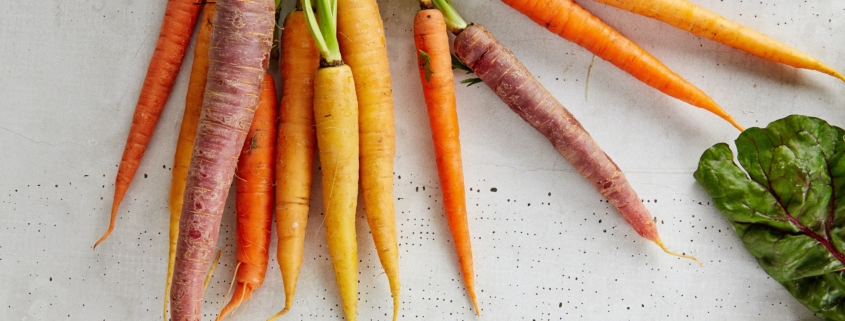Crazy for Carotene
With the abundance of nutrition articles available to the public, especially via internet publications, we are all exposed to more nutrition jargon than individuals in the past. Words such as “hydrogenated oils”, “carbohydrates”, and “omega-3s” are far more commonly used today than they were ten or twenty years ago. But many of the terms that get tossed around can be confusing, especially those that sound similar. One pair of nutrition words that some find confusing is “carotenoids” and “carotene”. So sit back, relax, and take two minutes to expand your vitamin vocabulary!
Carotenoids vs. Carotene
Carotenoids are natural pigments made by plants. They give the bright red, orange, and yellow colors to various fruits and vegetables. There are several of these pigments, or carotenoids, in foods. The most common include alpha- and beta-carotene, lycopene, lutein, zeaxanthin, and beta-cryptoxanthin.
So when you hear the word “carotenoids”, it is referring to a family of pigments, whereas the word “carotene” is referring to only one of the family members. Carotene (beta-carotene, to be exact) is the most studied, and so one of the most famous members of the carotenoid family. In fact, beta-carotene is what gives carrots their bright orange color, and was actually named after the vegetable!
Health Benefits
Okay, so now that we have the whole carotenoid-carotene situation straightened out, why do we even care? Well, it turns out that these color substances in the fruits and vegetables we eat actually play a significant role in our health. Some of their roles include:
- Acting as antioxidants, which protect our cells from damage and us against diseases such as cardiovascular disease and some cancers.
- Being assembled into vitamin A, which is important for normal development, mucous membrane, vision, and immune health. NOTE: Only some of the carotenoid family are able to transform into vitamin A. Those that are able to become vitamin A are called provitamin A carotenoids. The family members with this superpower include alpha- and beta-carotene and beta-cryptoxanthin. Lutein, zeaxanthin, and lycopene are the “normal” cousins who don’t have that transformation ability. But they are still important! In fact, lutein and zeaxanthin are the only carotenoids present in the retina and lens of the eye, helping you see.
Helpful Tips
Now that you’re sold on incredible carotenoids, how do you get your share? Make sure you grab deep red, orange, and yellow vegetables. Some of the best sources are carrots, winter squash, sweet potatoes, pumpkin, and tomatoes. Another great source that might surprise you is spinach and other dark leafy greens such as kale, collard greens, and dandelion greens. They are surprisingly chock-full of the orange carotenoid pigments, you just can’t see the orange color because it’s “hidden” from our eyes by the strong green pigments that the leaves contain.
And finally, don’t be afraid to cook your veggies – chopping and heating actually “free” the carotenoids, making them a little easier for your body to use.
– By Morgan McManimon-Myers, BS, RDN
Sources: US National Library of Medicine, National Institutes of Health, http://www.ncbi.nlm.nih.gov/pubmed/10511324; Oregon State University, Linus Pauling Institute of Micronutrient Research for Optimum Health, http://lpi.oregonstate.edu/infocenter/phytochemicals/carotenoids/




